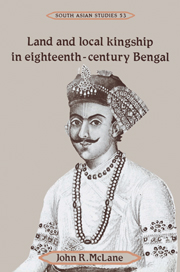Book contents
- Frontmatter
- Contents
- List of tables
- Preface and acknowledgments
- List of abbreviations
- Select glossary
- Map of southwest Bengal
- Part I Bengal
- Part II Burdwan
- 6 Mughal Burdwan and the rise of the Burdwan raj
- 7 Burdwan's expansion
- 8 The Maratha invasions, 1742-1751
- 9 Zamindars and the transition to Company rule
- 10 The famine of 1770
- 11 Revenue farming, 1771-1777
- 12 Zamindari family politics: the Burdwan raj, 1770-1775
- 13 The politics of Burdwan family debt and marriages, 1775-1778
- 14 Testing the limits, 1778–1790
- 15 Burdwan under the Decennial and Permanent Settlements
- 16 Patnis and the elusive quest for independence and security
- 17 Conclusion
- Bibliography
- Index
- Cambridge South Asian Studies
14 - Testing the limits, 1778–1790
from Part II - Burdwan
Published online by Cambridge University Press: 13 October 2009
- Frontmatter
- Contents
- List of tables
- Preface and acknowledgments
- List of abbreviations
- Select glossary
- Map of southwest Bengal
- Part I Bengal
- Part II Burdwan
- 6 Mughal Burdwan and the rise of the Burdwan raj
- 7 Burdwan's expansion
- 8 The Maratha invasions, 1742-1751
- 9 Zamindars and the transition to Company rule
- 10 The famine of 1770
- 11 Revenue farming, 1771-1777
- 12 Zamindari family politics: the Burdwan raj, 1770-1775
- 13 The politics of Burdwan family debt and marriages, 1775-1778
- 14 Testing the limits, 1778–1790
- 15 Burdwan under the Decennial and Permanent Settlements
- 16 Patnis and the elusive quest for independence and security
- 17 Conclusion
- Bibliography
- Index
- Cambridge South Asian Studies
Summary
Throughout Bengal in 1777, the Company restored zamindars to the lands that had been farmed out in the auctions of 1772. There was no enthusiasm for the zamindars. Company officials regarded many zamindars as incompetent, untrustworthy, and/or impoverished. Zamindars were viewed as the best of several flawed agencies of collection. Revenue farmers had proved unreliable because they had no long-term interest in their farms and because they met with resistance from subordinate rent collectors. Direct government collection from the villages had also failed. Zamindars were restored because they were assumed to have a long-term interest in the prosperity of their territories and because they commanded access to credit and a respect that gave them the potential for efficient collection. The main question in the late 1770s was not who should make collections but rather what the revenue demand should be and what reforms should be introduced into zamindaris often in arrears.
There was no consensus in the late 1770s and 1780s about the proper level for revenue assessments. Parts of Bengal were still depopulated as a result of the famine. It had been hoped that the Amini Commission would discover whether people such as Philip Francis were correct in their view that Bengal was over-assessed. Although the Commission reported in 1778 that large amounts of land had been improperly alienated revenue-free and, if resumed, would add to the revenue, the commission took no position on whether Bengal was over- or under-assessed. Thus, only future experience would tell if the zamindars were capable of paying an increased demand.
- Type
- Chapter
- Information
- Land and Local Kingship in Eighteenth-Century Bengal , pp. 251 - 266Publisher: Cambridge University PressPrint publication year: 1993



